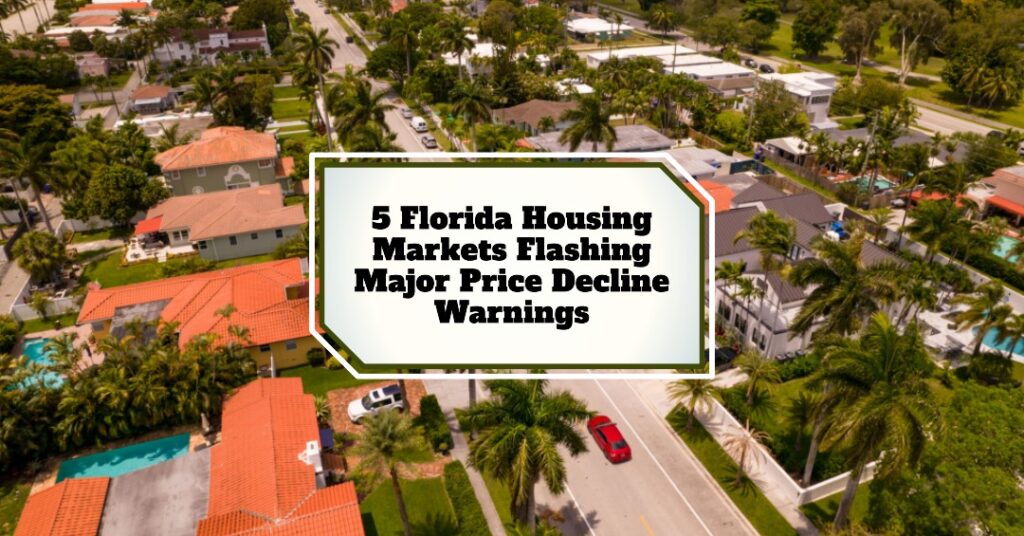Florida Housing Market: 5 Areas Facing Major Price Declines
The Florida housing market has experienced an unprecedented rollercoaster over the past few years. Prices surged dramatically, influenced by an influx of residents seeking sunny weather and affordable living. However, according to data from Cotality (previously CoreLogic) for April 2025, a shift is underway. Some Florida markets are now at a high risk of significant price declines. Here’s what you need to know about these regions and the factors at play.
The Current State of Florida’s Housing Market
In recent months, signs indicate that the rapid home price growth is slowing. The national average year-over-year growth dropped to 2.0% in April 2025, the slowest rate since Spring 2012. Although certain parts of the U.S. continue to see price increases, states like Florida are facing declines, with the statewide average appreciation dipping to -0.8%.
Key Statistics
- National Home Price Growth: 2.0% (April 2025)
- Florida Home Price Growth: -0.8%
- Florida’s Median Sales Price: $390,000 (below national median of $395,000)
Why Is Florida Feeling the Pressure?
Several factors contribute to Florida’s market cooling:
- Affordability Challenges: Despite recent price dips, homes are still significantly more expensive than pre-pandemic levels, resulting in potential buyers being priced out.
- Increased Inventory: A slowing market leads to homes staying on the market longer, resulting in a surplus of inventory that decreases sellers’ leverage.
- Slower Migration Trends: Although people are still moving to Florida, the frantic pace has slowed, with rising living costs influencing decisions.
- Investor Pullback: With higher interest rates, investors are becoming more hesitant, reducing demand in the housing market.
Florida Markets with High Price Decline Risks
Cotality’s analysis has flagged five Florida markets that pose the highest risk for price declines:
- Cape Coral, FL
- Lakeland, FL
- North Port, FL
- St. Petersburg, FL
- West Palm Beach, FL
1. Cape Coral, FL
Cape Coral tops the list, showing a 6.5% decline in home prices year-over-year. Once a popular choice due to affordability, prices are now below levels seen in 2022.
2. Lakeland, FL
Located between Tampa and Orlando, Lakeland has experienced a steady price decline as well, driven by a rise in available inventory and changes in market dynamics.
3. North Port, FL
North Port is another area feeling the heat, experiencing a 4.3% drop in home prices. Rapid appreciation has led to significant volatility, resulting in ongoing risks in the market.
4. St. Petersburg, FL
Renowned for its vibrant culture and beautiful beaches, St. Petersburg saw home prices hit a peak just shy of $450k but has recently shown signs of gradual decline.
5. West Palm Beach, FL
West Palm Beach displays one of the most volatile trends, with sharp price fluctuations reflecting the market’s struggle to find a balance amid cooling demand.
Understanding the Factors Behind High Risk
The markets flagged by Cotality share common characteristics:
- Rapid Price Appreciation: These markets saw significant price increases that now appear unsustainable.
- High Influx of Buyers: Skewed demand driven by out-of-state investors and retirees escalated home values.
- Local Economic Pressures: Elements such as rising homeowner’s insurance costs uniquely affect specific markets in Florida.
What This Means for Buyers, Sellers, and Homeowners
For Buyers
- Opportunity Awaits: With prices cooling, strategic buying may yield advantages. However, be cautious and understand local market conditions.
- Research is Key: Delve into neighborhood specifics and the overall cost of ownership, including high insurance rates.
For Sellers
- Set Realistic Prices: Accurate pricing based on current market dynamics is essential.
- Expect Changes: Be prepared for prolonged time on the market and potential negotiations.
For Homeowners
- Monitor Market Value: Increased awareness of potential value declines can help in financial planning.
- Budget for Rising Costs: Keep in mind growing expenses such as insurance and property taxes, which may impact your total ownership costs.
Conclusion: Keeping an Eye on Florida’s Housing Future
The shifting dynamics in Florida’s housing market signal an essential period of reflection and adjustment. As trends in migration, demand, and economic conditions evolve, it’s crucial to monitor these shifting landscapes closely.
Key Takeaways
- Key Florida markets are experiencing notable price declines amid cooling demand.
- Understanding local factors is critical for navigating the current real estate climate.
- Both buyers and sellers must adapt strategies based on emerging trends.
Stay informed by checking out sources such as Cotality for the latest insights into the housing market trends. With data-driven decisions, homeowners and investors can better navigate the complexities of Florida’s real estate landscape.


